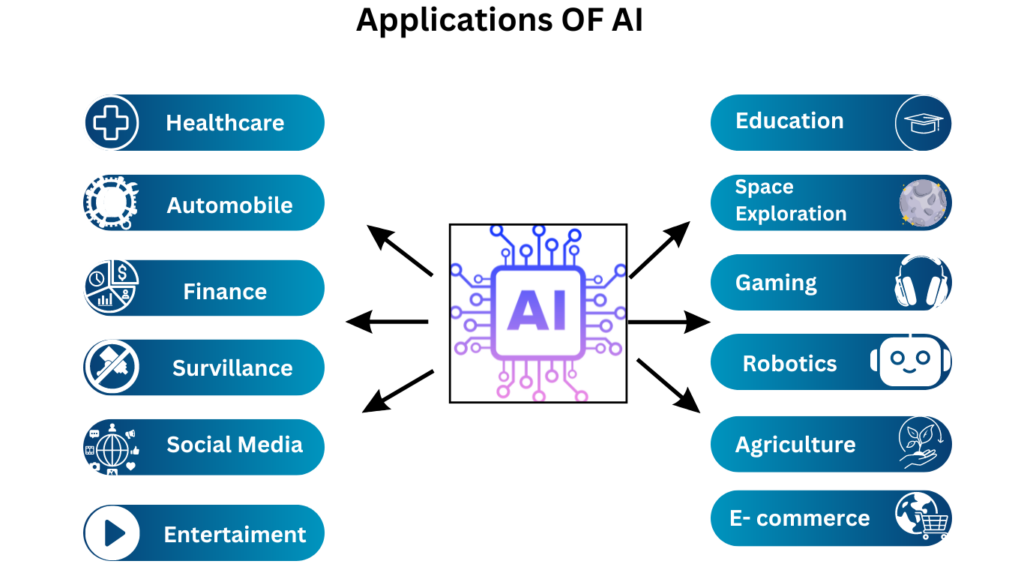AI And ML
Our Services > Page
Introduction to AI and ML
Artificial Intelligence (AI): Artificial Intelligence (AI) refers to the simulation of human intelligence in machines that are programmed to think and learn like humans. These machines can perform tasks that typically require human intelligence, such as visual perception, speech recognition, decision-making, and language translation.
Types of AI:
- Narrow AI (Weak AI): This type of AI is designed and trained for a specific task. Examples include virtual personal assistants like Siri and Alexa, which perform specific tasks such as setting reminders or playing music.
- General AI (Strong AI): This type of AI has broader capabilities similar to human intelligence and can perform any intellectual task that a human can. General AI is still largely theoretical and not yet achieved.
Applications of AI: AI is used in various fields including healthcare (diagnosing diseases, personalized treatment), finance (fraud detection, algorithmic trading), customer service (chatbots, personalized recommendations), and more.
Machine Learning (ML): Machine Learning (ML) is a subset of AI that involves training algorithms on data to enable them to make predictions or decisions without being explicitly programmed for each task. It focuses on the development of algorithms that can learn from and make predictions on data.
Types of Machine Learning:
Supervised Learning: The algorithm is trained on a labeled dataset, which means that each training example is paired with an output label. The goal is to learn a mapping from inputs to outputs. Examples include:
- Classification: Assigning inputs to predefined categories (e.g., spam detection in emails).
- Regression: Predicting a continuous output (e.g., predicting house prices).
Unsupervised Learning: The algorithm is given data without explicit instructions on what to do with it. It tries to learn the underlying structure of the data. Examples include:
- Clustering: Grouping data points into clusters based on similarity (e.g., customer segmentation).
- Association: Discovering rules that describe large portions of the data (e.g., market basket analysis).
Reinforcement Learning: The algorithm learns by interacting with an environment and receiving rewards or penalties. It aims to learn a policy that maximizes cumulative rewards. This is often used in gaming and robotics.

Important Algorithms and Techniques
- Linear Regression and Logistic Regression: Basic algorithms for regression and classification tasks.
- Decision Trees and Random Forests: For classification and regression tasks, useful for understanding feature importance.
- Support Vector Machines (SVM): Effective in high-dimensional spaces for classification.
- Neural Networks and Deep Learning: Powerful models for complex tasks like image and speech recognition.
- Clustering Algorithms (e.g., K-Means, Hierarchical): For grouping data points in unsupervised learning.
- Natural Language Processing (NLP): Techniques like tokenization, sentiment analysis, and language modeling for working with text data.
Practical Applications
Customer Experience
- Personalization: AI tailors product recommendations and content based on user behavior and preferences.
- Chatbots: AI-powered chatbots provide instant customer support, improving response times and customer satisfaction.
- Sentiment Analysis: Analyzes customer feedback to gauge sentiment and improve products/services.
Healthcare
- Disease Prediction: ML algorithms predict diseases by analyzing medical data and patient history.
- Personalized Treatment: AI helps develop customized treatment plans based on individual patient data.
- Medical Imaging: AI enhances the accuracy of diagnosing diseases through analysis of medical images like X-rays and MRIs.
Finance
- Fraud Detection: AI models detect fraudulent transactions by identifying unusual patterns.
- Algorithmic Trading: AI algorithms execute trades at optimal times, maximizing profits.
- Risk Management: ML assesses financial risks by analyzing market trends and data.
Manufacturing
- Predictive Maintenance: AI predicts equipment failures, reducing downtime and maintenance costs.
- Quality Control: ML algorithms detect defects in products during the manufacturing process.
- Supply Chain Optimization: AI improves supply chain efficiency by predicting demand and managing inventory.
Transportation
- Autonomous Vehicles: AI drives the development of self-driving cars, improving safety and efficiency.
- Route Optimization: ML algorithms optimize delivery routes, saving time and fuel.
- Traffic Management: AI analyzes traffic patterns to optimize traffic flow and reduce congestion.
Overall,Artificial Intelligence and Machine Learning are revolutionizing various sectors by enabling machines to learn from data and perform tasks that traditionally required human intelligence. With advancements in these technologies, we are witnessing significant improvements in efficiency, accuracy, and capabilities across diverse industries. Understanding the basics of AI and ML is crucial for leveraging their full potential and staying ahead in the rapidly evolving technological landscape.

